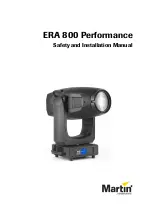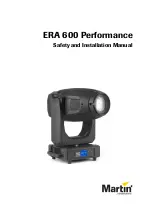
1.
SAFETY OFPERATION RULES
1. SECURE WORK. Use chuck to hold workpiece when practical. It’s more safer
than using your hand and it frees both hands to operate tool.
2. DON’T OVERREACH. Keep proper footing and balance at all times.
3. MAINTAIN TOOLS WITH CARE. Keep tools sharp and clean for the best and
the safest performance. Follow instructions for lubricating and changing
accessories.
4. DISCONNECT TOOLS before servicing, when changing accessories such as
cutting tools.
5. REDUCE THE RISK OF UNINTENTIONAL STARTING. Make sure switch is in
off position, before intend plugged in.
6. USE RECOMMENDED ACCESSORIES. Consult the owner’s manual for
recommended accessories. The use of improper accessories may cause risk
or injury to persons.
7. NEVER STAND ON TOOL. Serious injury could occur, if the tool is tipped or
if the cutting tool is unintentionally contacted.
8. CHECK DAMAGE PARTS. Before further use or the tool, a guard or other part
that is damaged should be carefully checked to determine that it will
operate properly and perform its intended function, check for alignment of
moving part binding of moving parts, breakage of parts, mounting, and any
other conditions that may affect its operation. A guard or other part that is
damaged should be properly repaired or replaced.
9. NEVER LEAVE TOOL RUNNING UNATTENDED TURN POWER OFF. Don’t leave
tool until it comes to a complete stop.
10. ALWAYS USE SAFETY GLASSES. Common eyeglasses only have impact
resistant lenses, they are NOT safety glasses.
11. KEEP GUARDS IN PLACE and in working order.
12. REMOVE ADJUSTING KEYS AND WRENCHES. Form habit of checking to
see that keys and adjusting wrenches are removed from tool before turning
it on.
13. KEEP WORK ARE A CLEAN. Cluttered areas will invite accidents.
14. DON’T USE IN DANGEROUS ENVIRONMENT. Don’t use power tools in
damp or wet location, or expose them to rain. Keep work area well lighted.
15. KEEP CHILDREN AWAY. All visitors should be kept safe distance from work
area.
16. MAKE WORKSHOP CHILD PROOF with padlocks, master switches, or by
removing starter keys.
17. DON’T FORCE TOOL. Don’t force tool or attachment to do a job for which
it was not designed.
18. USE RIGHT TOOL. It will do the job better and safer at the rate for which
it was designed.
19. WEAR PROPER APPAREL. No loose clothing, gloves, neckties, rings
bracelets, or other jewelry to get caught in moving parts. Non-slip footwear
is recommended, wear protective hair covering to contain long hair.
20. Never use the high speed over one hour.
21. KEEP TURNING TOOLS TIGHT during operating.
02
Summary of Contents for DYNAMIC 21120GH
Page 5: ...03 2 SPECIFICATIONS ...
Page 7: ...05 PREPARATION FOR OPERATION ...
Page 8: ...06 ...
Page 9: ...07 ...
Page 10: ...3 ELECTRICAL CIRCUIT DIAGRAM 08 ...
Page 11: ......
Page 12: ......
Page 13: ...8 2 1 ...
Page 14: ...8 2 2 ...
Page 15: ......
Page 16: ......
Page 17: ...09 4 ELECTRICAL CIRCUIT DIAGRAM CE CONFORMITY ...
Page 19: ......
Page 20: ......
Page 21: ......
Page 22: ......
Page 23: ......
Page 24: ......
Page 25: ...17 ...
Page 26: ...18 ...
Page 27: ...19 5 OPERATION MACHINE LIFTING ...
Page 28: ...FOUNDATION DRAWING 20 ...
Page 29: ...OPERATION 21 ...
Page 32: ...24 OPERATION ...
Page 35: ...27 ...
Page 36: ...28 ...
Page 37: ...29 ...
Page 38: ...30 THREADING ...
Page 39: ...31 6 LUBRICATION ...
Page 40: ...32 ...
Page 41: ...33 ...
Page 42: ...34 7 TROUBLE CAUSE TROUBLE SHOOTING ...
Page 43: ...35 8 MECHANICAL DRAWING ...
Page 44: ...36 ...
Page 45: ...37 ...
Page 46: ...38 ...
Page 47: ...39 ...
Page 48: ...40 ...
Page 51: ...41 ...
Page 52: ...42 ...
Page 53: ...43 ...
Page 54: ...44 ...
Page 55: ...45 ...
Page 56: ...46 Gear Box ...
Page 57: ...47 ...
Page 61: ...51 Apron ...
Page 62: ...52 ...
Page 63: ...53 ...
Page 64: ...54 Carriage ...
Page 65: ...55 ...
Page 66: ...56 ...
Page 67: ...57 ...
Page 68: ...58 ...
Page 69: ...59 ...
Page 70: ...60 ...
Page 71: ...61 ...
Page 72: ...62 ...
Page 76: ...STEADY REST 66 ...
Page 79: ...TAPER TURNING ATTACHMENT 69 ...





































